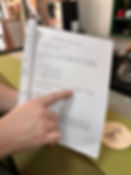60 Traditional Chinese Tea Terms
- Amy Aed
- Jul 24, 2024
- 5 min read
Updated: Feb 10
When first entering the world of tea, the sheer abundance of tea terms can be super confusing. But, the more we learn, the better we understand the very beverage that we all know and love.
Currently, the Eisa Tea Co. team can be found exploring the beautiful island of Taiwan, scouring the best teas from the best farms - an incredibly easy task in such a tea-rich country. Here, tea terminology can be found in both English and traditional Chinese, making for an even richer knowledge of the iconic drink.
So, why not make things a little more interesting?
Join us as we delve further into the world of tea with the 60 most-used tea terms, and their equivalents in traditional Chinese.

茶 (chá) - This is the word for 'tea' itself. This is arguably the most important word you're going to learn.
茶葉 (chá yè) - This means 'tea leaves.' When you’re buying tea, you might want to ask about the quality of the 茶葉.
茶壺 (chá hú) - This refers to a teapot. In some tea cultures, the teapot is almost as important as the tea itself.
茶杯 (chá bēi) - This is a tea cup. There are various styles, but all are important for proper tea tasting.
功夫茶/ 工夫茶 (gōng fu chá) - This translates to 'Kung Fu tea' or 'Gongfu tea,' a traditional Chinese tea ceremony that involves the ritualistic preparation and presentation of tea.
綠茶 (lǜ chá) - This is green tea, one of the most popular types of tea.
白茶 (bái chá) - This is white tea, the least processed type of tea known for its delicate flavour.
黃茶 (huáng chá) - Yellow tea, a rare and traditional type of tea with a unique processing method that gives it a yellowish colour and mellow flavour.
烏龍茶 (wū lóng chá) - This is oolong tea, the primary tea found in Taiwan, with a unique flavour and aroma. 紅茶 (hóng chá) - This means 'black tea.' Interestingly, what Westerners call black tea is called red tea in the East.
普洱茶 (pǔ ěr chá) - This is Pu-erh, a type of post-fermented tea.
茶道 (chá dào) - 'The way of tea', the philosophy and rituals associated with tea drinking.
茶具 (chá jù) - 'Tea set'
泡茶 (pào chá) - This means 'to brew tea.' Knowing how to properly 泡茶 can enhance your tea-drinking experience.
品茶 (pǐn chá) - This translates to 'tea tasting', the practice of appreciating the flavour, aroma, and quality of the tea.

茶藝 (chá yì) - This is 'tea art,' referring to the skill and artistry involved in the ceremonial preparation of tea.
茶香 (chá xiāng) - This is the tea fragrance; the aroma of tea is an essential aspect of its appreciation.
茶葉罐 (chá yè guàn) - This is a tea caddy used for storing tea leaves.
茶盤 (chá pán) - This translates to 'tea tray,' used to hold the tea set during preparation and serving.
茶壺蓋 (chá hú gài) - This means 'teapot lid,' an essential part of the teapot.
茶藝師 (chá yì shī) - This is a tea master, someone skilled in the art of tea preparation and presentation.
茶道具 (chá dào jù) - This refers to tools used in the tea-making process.
茶房 (chá fáng) - This translates to 'tea room,' a space dedicated to drinking and appreciating tea.
茶樓 (chá lóu) - This means 'tea house,' a place where tea is served, often with light snacks.
茶湯 (chá tāng) - This means 'tea soup,' a term used to describe the brewed tea liquid.
茶花 (chá huā) - Sometimes used to refer to the blossoms of the tea plant.
茶農 (chá nóng) - This is the word for tea farmer.
茶食 (chá shí) - This translates to 'tea snacks,' the small foods served alongside tea.
茶葉蛋 (chá yè dàn) - This means 'tea egg,' a traditional savoury snack made by boiling eggs in tea, soy sauce, and spices.

茶湯顏色 (chá tāng yán sè) - This means 'tea soup colour,' referring to the colour of the brewed tea.
發酵 (fā jiào) - This is the process of fermentation, referring to the natural enzymatic process that changes the chemical structure of the tea leaves.
氧化 (yǎng huà) - This translates to 'oxidation.'
殺青 (shā qīng) - This means 'fixing' or 'kill-green.' It involves heating the tea leaves to stop oxidation, a key step in green tea production.
揉捻 (róu niǎn) - This translates to 'rolling.' It involves rolling the tea leaves to shape them and to break the cell walls, enhancing flavour release.
乾燥 (gān zào) - 'Drying', the process of removing moisture from the tea leaves to preserve them.
萎凋 (wěi diāo) - This translates to 'withering.' It involves letting the freshly picked leaves lose some of their moisture before further processing.
解塊 (jiě kuài) - This is 'unclumping', the step of separating clumped tea leaves after rolling.
焙火 (bèi huǒ) - This translates to 'roasting.' It's used to enhance the flavour and aroma of the tea leaves, particularly in oolong tea.
曬青 (shài qīng) - This means 'sun-drying.' It's a traditional method of drying tea leaves in the sun.
涼青 (liàng qīng) - This translates to 'air-drying.' It's the process of drying tea leaves in the open air.
篩分 (shāi fēn) - This means 'sifting', the process which separates the tea leaves based on size and quality.
發汗 (fā hàn) - This translates to 'sweating', a fermentation step used in the production of Pu-erh tea.
壓餅 (yā bǐng) - This is also a term used for making Pu-erh, whereby you press the leaves into cakes.
分級 (fēn jí) - This is the stage of sorting tea leaves into different quality grades.

揀選 (jiǎn xuǎn) - This means 'sorting,' which is the manual selection of tea leaves to ensure quality.
拼配 (pīn pèi) - This is the process of blending different batches of tea leaves to achieve a consistent flavour.
冷卻 (lěng què) - The step of letting the tea leaves cool down after heating or drying.
回潮 (huí cháo) - This means 're-moistening.' It involves adding moisture back to tea leaves to improve texture and pliability during rolling.
窨制 (xūn zhì) - The process of infusing tea leaves with fragrant flowers, such as jasmine, to add aroma.
手工製茶 (shǒu gōng zhì chá) - 'Handmade tea.'
機加工 (jī jiā gōng) - 'Machine processing.'
整形 (zhěng xíng) - The process of shaping the tea leaves into specific forms during processing.
茶梗 (chá gěng) - The stems of the tea leaves that are sometimes included in the final product.
芽茶 (yá chá) - Tea made primarily from the buds of the tea plant.
老茶 (lǎo chá) - Tea that has been aged to develop unique flavours, such as aged Pu-erh.
ㄧ心二葉 (Yīxīn èryè) - The 'one bud and two leaves' picking process.
生茶 (shēng chá) - 'Raw tea,' referring to raw (unfermented) Pu-erh tea.
熟茶 (shú chá) - 'Ripe tea,' referring to ripe (fermented) Pu-erh tea.
毛茶 (máo chá) - 'Maocha,' the rough tea leaves after primary processing but before further refinement.
回甘 (huí gān) - 'Returning sweetness,' the lingering sweet aftertaste of high-quality tea.
品鑑 (pǐn jiàn) - And finally, this is the practice of tasting tea to evaluate its quality.

And now, you should have a vague understanding of even rather complex tea conversations around the world. You're welcome!